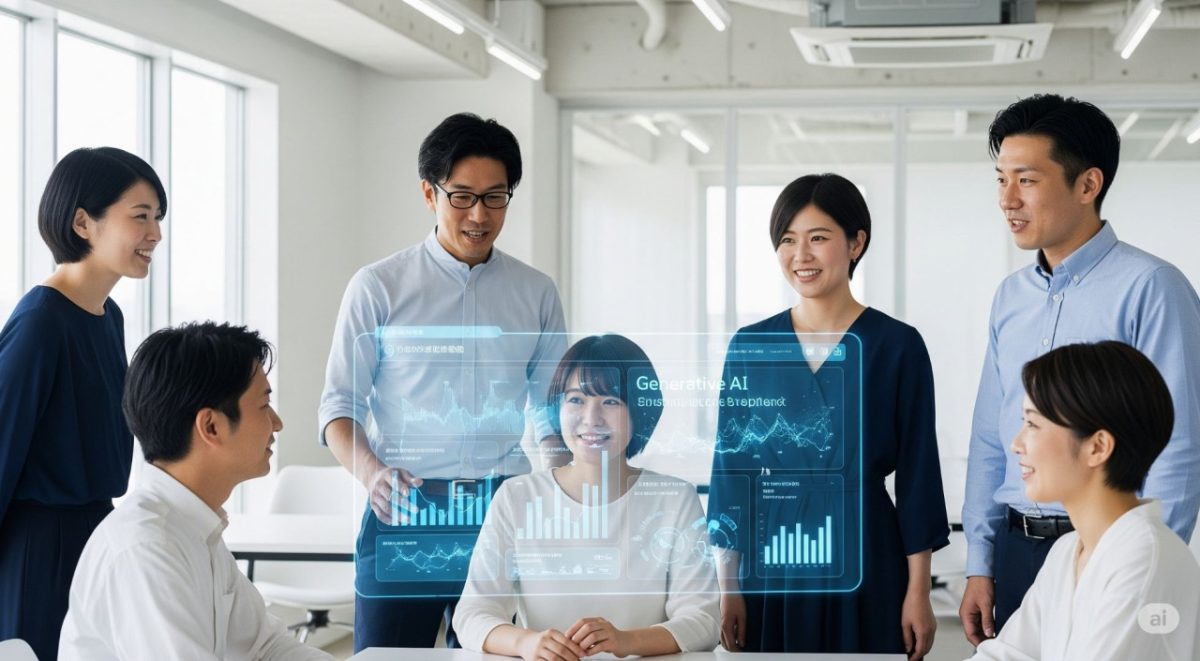Japan’s Gen AI CX Playbook: Why You Need a Road-map Before the Pilot
- Home
- Insights
- Articles
- Generative AI
- Japan’s Gen AI CX Playbook: Why You Need a Road-map Before the Pilot

For CX leaders, Generative AI is quickly transforming from a thought experiment to a hands-on operational tool.
A spring 2025 survey of 117 executives by Office Chatani found that four out of five large Japanese corporations have already launched, or set aside funding for, at least one Gen AI project. And yet, almost half admit they still lack a clear governance model or data-security plan.
The disconnect is stark, because when board-level urgency collides with procedural uncertainty, particularly in Japan where risk mitigation is just as prized as innovation, confusion abounds.
Tokyo’s policymakers have made the tightrope that organizations must walk even narrower. In April 2024 the Ministry of Economy, Trade and Industry (METI) issued its “AI Guidelines for Business Ver 1.0,” a soft-law framework that pushes responsibility for risk mapping, audit trails and human-in-the-loop reviews onto enterprises themselves. Unlike the EU’s prescriptive AI Act, Japan’s guidelines are voluntary – but board directors know voluntary can morph into mandatory overnight once an incident explodes on social media.
Having said that, brands that move first are already carving out measurable advantage. SoftBank Corp. has embarked on a multi-year build with Microsoft Azure and OpenAI to rewrite more than 10,000 contact-center scripts, aiming to shorten wait times and harmonise answers in Japanese, English and Chinese.
A few months later Rakuten Mobile rolled out “Rakuten AI for Business,” a multilingual generative-AI chat interface for corporate clients, positioning the carrier as a DX partner rather than just a network utility.
Financial institutions are following too, but with caution. A Bank of Japan report released in October 2024 shows that 60 percent of banks are trialling Gen AI but flag in-country data residency as the top barrier to production.
Meanwhile, union and labour groups are watching. IBM Japan agreed in August 2024 to disclose its AI decision logic to worker representatives – the first such transparency pact in the country.
Against this backdrop, the question for CX leaders is no longer whether to deploy Gen AI, but how to sequence the work so that enthusiasm doesn’t outrun compliance, culture or employee buy-in.
The CX Roadmap for Japan Starts at Phase 0
Western playbooks rarely mention nemawashi – the informal consensus-building that, in Japanese business culture, can consume weeks before a “rubber-stamp” meeting – or the need to brief unions on algorithmic impact before a proof-of-concept goes live. Japanese management experts describe nemawashi as the hidden root system that keeps a project upright.
This roadmap therefore starts with a Phase 0 “Assessment & Consensus” window – four weeks of discovery workshops, risk audits and stakeholder walk-throughs – before the countdown to a 90-day PoC even begins. From there, the roadmap spans five more phases: Vendor Readiness, Pilot Build, Wave 0 Production, Phased Roll-out and Continuous Optimisation. Each stage has Japanese-specific gates: a union-consultation milestone (post-IBM precedent), an APPI data-hosting checkpoint, an FSA compliance review for finance and telco verticals, and a policy horizon scan as Tokyo debates moving from soft law to a licence-based regime.
The stakes are clear. Firms that get Gen AI to scale first will cut average-handle-time, automate QA and surface proactive offers months before laggards finish their internal debates. The rest of this article shows exactly how to claim that edge, starting on calendar week one.
Phase 0 – Assessment & Consensus-Building (Weeks 1 – 4)
Before anyone even spins up a development sandbox, Japanese CX leaders map two things: business value and “governance debt.” Start by inventorying every dataset the contact center owns – call recordings, chat logs, CRM notes – and rating each for sensitivity under the criteria mentioned in the AI Guidelines for Business Ver 1.0 (such as risk mapping, human-in-the-loop, transparency, security, lifecycle monitoring) issued by METI. The same workshop should help you uncover CX pain-points (long queue times, QA backlog, after-call wrap-up) and link them to measurable KPIs.
Next comes nemawashi, the quiet persuasion ritual that often soaks up “60–70 percent of pre-decision time.” CX, IT, Legal, HR, Data-Governance and Works-Council reps meet individually – sometimes over bento, sometimes Slack – to test objections and draft a consensus narrative before any formal steering-committee vote. Western vendors underestimate this stage, but Japanese sponsors know missing even one stakeholder can add months later. Wrap Phase 0 with a single slide that lists the target use-cases ranked by value-to-risk, the datasets mapped to METI pillars, and a nemawashi progress check-box (“all critical voices briefed: yes/no”). Expect four weeks end-to-end.
Phase 1 – Readiness & Vendor Selection (Weeks 5 – 8)
With consensus in hand, procurement will move on to shortlisting vendors and technology stacks that satisfy the data-residency anxieties Japanese boards cite most. Azure’s OpenAI Service in the Tokyo and Osaka regions offers scale and local zones. Sovereign LLMs or on-prem GPU clusters answer Bank of Japan warnings that 60 percent of financial institutions see “in-country hosting” as their top Gen AI barrier. Run a quick APPI gap analysis for each option – what PII leaves Japan, what is pseudonymised, and who signs standard contractual clauses?
Just as critical is the need to engage organised labor early. Unions want the IBM Japan deal – which obligates it to reveal how AI influences employee evaluations – to become a template that other employers copy. Even if your pilot touches only customer data, HR and Works Councils will ask whether future models might score agent performance. Finish Phase 1 by issuing an RFP (or partner brief) that bakes in hosting, governance and labor-transparency needs, plus target KPIs.
Phase 2 – Proof-of-Concept (Weeks 9 – 12)
Build a redacted sandbox first, which means you strip PII, mask phone numbers, and wire in human-in-the-loop overrides that log every exception. Align audit trails to the METI pillars so compliance can reuse them later. Scope the pilot tightly, for example by focusing on a handful of high-volume customer intents, as SoftBank did when it began rebuilding more than 10,000 contact-center scripts in 2024. Keep the user group small (ten agents, one team lead) and track AHT, CSAT and summary-time delta daily.
Verticals under Japan’s Financial Services Agency or telecom regulator will likely have to pass a “PoC compliance gate.” The FSA’s March 2025 AI Discussion Paper calls for documented risk controls before any customer-facing test. End Phase 2 at Week 12 with a green-light memo if all the metrics are trending positive and there are no red flags.
Phase 3 – Pilot in Production (Weeks 13 – 16)
Flip the pilot to 10 percent live traffic (Wave 0), preferably with an off-peak queue. Every week compare AHT, escalation rate and CSAT against the four-week pre-pilot baseline and email a one-page dashboard to the exec sponsor. If AHT improves by less than, say, 15 percent or CSAT drops, pause and tune before scaling.
Week 16 is decision day. The Go/No-Go brief gives details on KPI variance, customer-sentiment analysis (social listening + verbatims), and any compliance incidents. A “go” unlocks Wave 1. A “no-go” loops back to data-quality fixes or model-prompt tweaks. Japanese boards respect this cadence. The criteria are transparent and there is no loss of face if the team says, “not yet.”
Phase 4 – Wave 1 & Wave 2 Roll-outs (Weeks 17 – 36)
Wave 1 scales to 40 percent traffic and multilingual coverage (if needed). Rakuten Mobile followed a similar path when it expanded its “AI for Business” service beyond Japanese in early 2025. This is also when DevOps stands up a production-grade private-cloud or sovereign cluster if the sandbox lived on public IaaS.
Wave 2 (Weeks 27–36) can layer in more advanced AI technologies, such as rich-media Visual IVR flows or even employee-wellness enhancements like SoftBank’s AI filter that converts angry caller tones to calmer speech. Post-launch, the Works Council receives a drift-test report including hallucination rate, bias checks, and steps taken to resolve these. The program graduates to “business as usual.”
Phase 5 – Continuous Optimisation & Policy Horizon-Scanning (Week 37 onward)
Generative models drift and Japanese regulators evolve. Set a quarterly cadence to retrain your models on fresh transcripts, refresh prompt libraries, and realign KPIs. Fee adjustments tied to cost-to-serve savings or upsell revenue lifts can keep your tech vendors or partners hungry. Each quarter, refresh the risk register and run a 48-hour rollback drill (in case you need to do this for real at any point).
Meanwhile, keep an eye on the Diet. A February 2025 CSIS (Centre for Strategic & International Studies) interview with former METI adviser Hiroki Habuka suggests Japan may pivot from today’s soft-law stance to a licence-based AI Act as early as 2026. Build a standing “policy scan” work-stream, which could include monitoring Cabinet Office papers, joining industry task forces, and scenario-planning for tighter rules. The prize for vigilance is simple – roll-outs continue, unbroken, while slower rivals freeze to rewrite compliance.
Road-map cheat-sheet
| Phase | Week window | Milestones | Decision gates ◆ | Unique JP nuances |
| 0 Assessment & Consensus | 1 – 4 | Use-case inventory, METI risk map | ◆ Nemawashi completion checklist | 60-70 % of prep time spent in informal alignment |
| 1 Readiness & Vendor pick | 5 – 8 | Hosting shortlist; APPI gap analysis | ◆ Union briefing sign-off (IBM precedent) | BoJ survey shows data-residency top barrier for 60 % of banks |
| 2 PoC build | 9 – 12 | Sandbox + 5 intents; METI audit trail | ◆ FSA compliance nod (finance/telco) | SoftBank began the same way – 5 high-traffic scripts → 10k processes |
| 3 Wave 0 prod pilot | 13 – 16 | 10 % live traffic; weekly KPI scan | ◆ Exec Go/No-Go (ΔAHT ≥ -15 %) | Culture: face-saving “pause for tuning” option normalises iteration |
| 4 Wave 1-2 scale-up | 17 – 36 | 40 % traffic; bilingual; Visual IVR | ◆ Works-Council post-audit | Voice-softening AI for agent wellness enters roadmap (SoftBank FY 26) |
| 5 Optimise & Horizon scan | 37 – 52 + | Quarterly drift retrain; gain-share review | ◆ Annual policy review (METI/Diet) | CSIS interview hints at licence-based AI Act by 2026 |
Your next 90 days
A Japanese Gen AI roll-out lives or dies on a solid project plan. Phase 0 nemawashi ensures no hidden veto. Phase 1 union engagement prevents last-minute derailers. Phase 2 PoC proves value in a sandbox managers can demo to all stakeholders. Stack those moves across a 52-week Gantt – complete with decision diamonds for every cultural or regulatory gate – and Gen AI stops being an experiment and starts compounding ROI.
Ready to explore what next-generation customer experience really looks like? Book a guided tour of the TMJ Generative Solution Showroom in Nishi-Shinjuku. In under two hours, your team will experience live demonstrations of real systems used in actual contact centers—spanning AI chatbots, VoiceBots, automated QA, Visual IVR, and operator-assist tools.
You’ll also speak directly with our experts in CX design and transformation, who will walk you through practical use cases and system integration points tailored to your business. It’s not a sales pitch—it’s a hands-on look at what’s already working in Japan’s most demanding service environments. Virtual tours are available if you’re not in the Tokyo area.
Click here to book your time slot
Related Insights
Expand Your Business in Japan Today!
Unlock growth opportunities in the Japanese market with our expert support. Contact us to explore how we can help you succeed.





